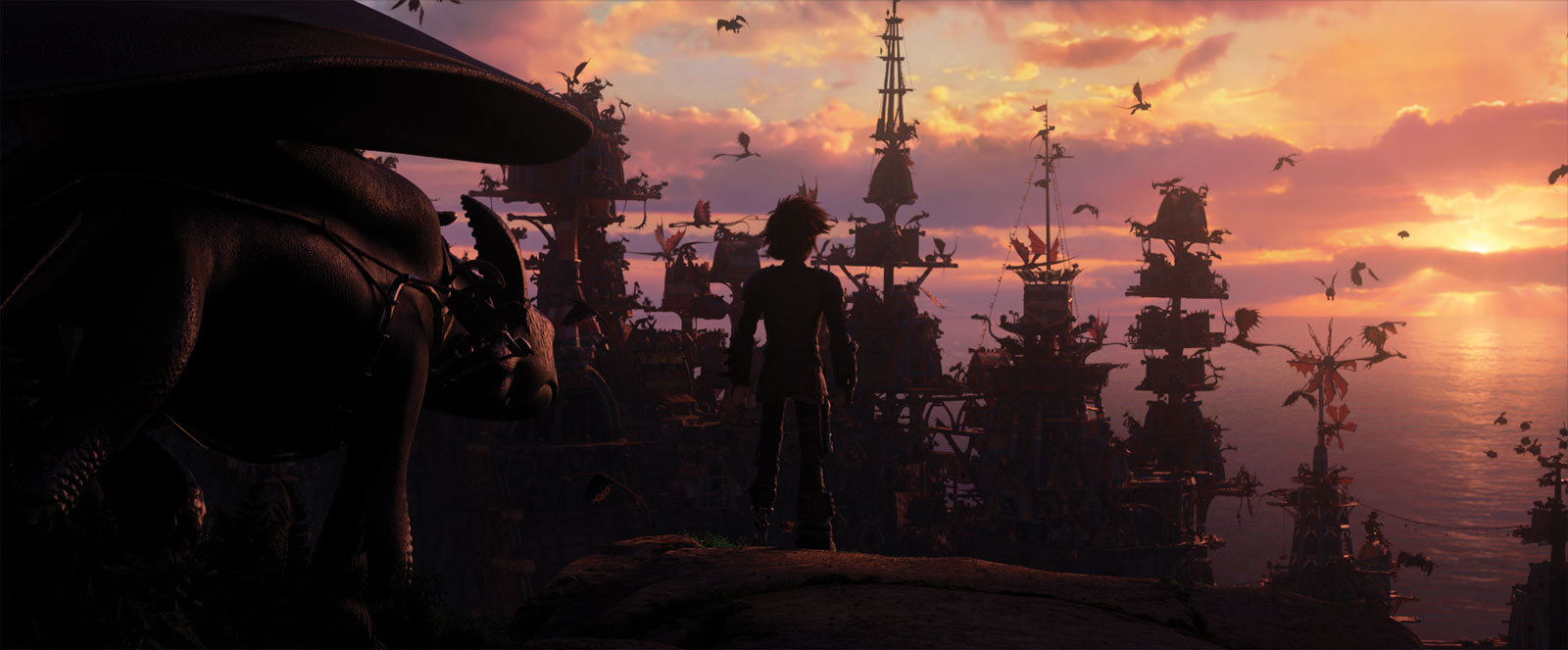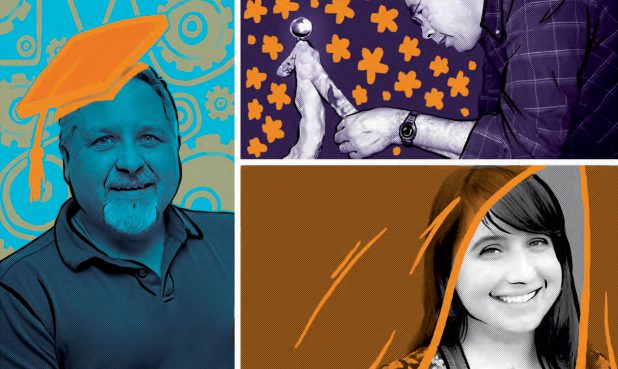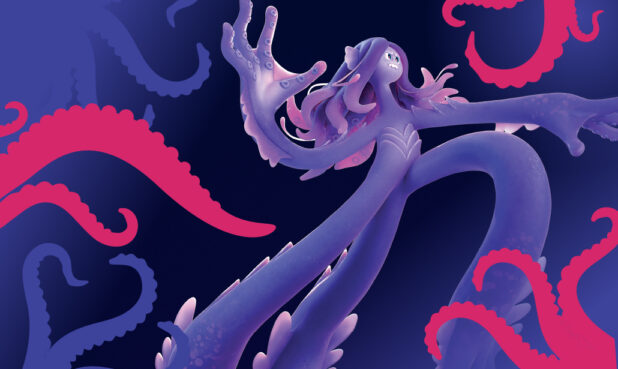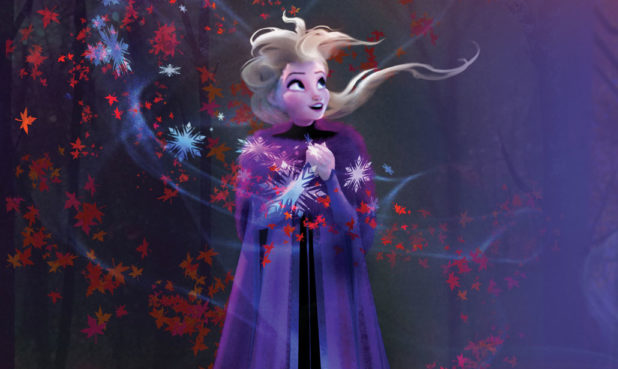It’s never easy for parents to watch their babies spread their wings and fly off on their own. It’s even harder if you’re the “parents” orchestrating these acts.
Such was the case with the artists working on How to Train Your Dragon: The Hidden World, the third feature film in the franchise—and one that benefited from employing many of the same crew members since the first chapter of DreamWorks Animation’s 3D computer-animated story broke barriers on the medium’s capabilities nearly a decade ago. This allowed for a deep understanding of how these characters and their worlds had to seem like natural extensions of the preceding films.
“It’s amazing just how you can connect with an audience using these tools and techniques we have at our disposal,” says Dean DeBlois, who directed all three films. “In CG animation, we have improved controls every year and [now] every character has thousands of controls built into them, that the animators can use to create the most subtle of expressions,” DeBlois says, explaining that the time can now be spent on emotional gratification rather than accuracy because “the transitions between those expressions become just completely smooth.”
For this film, DeBlois and his crew had to seamlessly master the arts of story trajectory, production design and advancing digital technology to further let their audience into a secret (or forgotten) world where beasts soar through the air, Vikings quest, and a man’s best friend can take him for a ride into the stars before dragons left humans for the safety of their own world.
Animated Characters That Come Alive
The third film, which premiers February 22, completes the saga of a young Viking named Hiccup (Jay Baruchel), who goes from an awkward, gangly protagonist to become the thoughtful, protective leader that is his destiny. But it also shows Hiccup in two other stages of life, thanks to flashbacks to him as a boy even younger than he was when the movie franchise started and eventually showing him as a grown man with a family of his own. All these designs had to both match each other and stay true to how the character looked in the previous films.

DeBlois says it would be a disservice to the character to suddenly have him grow to look like the 300-pound burly men who populate his colony, so “we tried to maintain that idea that he’s always going to be lean and spry but his tenacity would remain in place so that he could always be in a different mindset—a forward-thinker.”
Hiccup’s also an amputee, having lost part of his leg at the end of the first movie. Although he walks with a (quite stylish) peg leg, this affects how he moves as he ages. It’s also something the staff took great care to get right, lest they unintentionally offend any fans. Simon Otto, Dragon’s Head of Character Animation, says the fact that Hiccup treats his prosthetic as almost like a Swiss Army knife of gadgetry “opened up opportunities from a design point of view.” They also talked to disability advocacy groups about this aspect and whether certain language was appropriate and would not offend.
Other character details were more subtle. Dave Walvoord, the film’s Visual Effects Supervisor, says changes in the world of VFX since the first film meant that he and his team could fully embrace physically based rendering (PBR), the shading model that makes designs look more realistic.

Many characters got tiny makeovers because one small change, like an update to Hiccup’s dragon armor or the hair movement on his girlfriend and eventual wife, Astrid. Characters now have pores and peach fuzz on their faces—attributes that would have previously been taboo or looked unrealistic but now make them look more life-like.
This is also true for new characters like The Hidden World’s main villain, Grimmel, voiced by F. Murray Abraham. And, wouldn’t you know it? He looks a lot like the venerable actor (the animators are big fans of Abraham’s work in Miloš Forman’s 1984 Amadeus). Supervising animator Rani Naamani did an animation test using Abraham’s voice and, like kismet, the actor signed on afterward.
A Home of One’s Own
There is also an actual hidden world to discover in The Hidden World and it’s a bright one. This secret cavernous space that’s at the end of the world as we know it is where dragons can let their true colors shine. It’s where their scales change to blend with what seems tantamount to a raging Carnival filled with neon stalagmites and it holds a center stage where Hiccup’s sweet-tempered Toothless officially begins his own reign with a mighty roar.
“It’s amazing just how you can connect with an audience using these tools and techniques we have at our disposal…”
Dean DeBlois
Especially since we first glimpse this hidden world through the eyes of humans who stumble upon it, Head of Lighting Pablo Valle says that DeBlois and Production Designer Pierre-Olivier Vincent wanted to create a place that had the “wonder of going to a land that we have never seen before” but also one where “you can totally believe and relate that the dragons will be at home there.” Since it is in the middle of the earth, Valle says that they had to think about the particular types of crystals and vegetation that could grow there and would have a certain “bioluminescence”—sometimes, this the only light source in this scene. They looked at paintings and nature photography from regions as vastly different as Iceland and Hawai‘i and mixed together those color palettes. When it came to rendering, he says “the lighters generated 2D ‘maps of influence’ for the biolum that could then be further tweaked in terms of color, saturation and intensity in the compositing stage to achieve the desired look.”
VFX Supervisor Walvoord adds that the decision to make these geometric shapes glow wasn’t the hard part; it was “trying to get all the noise out” from the other people and objects. They wrote ray tracing code that would have separate passes for what they wanted to illuminate.
Production Designer Vincent says the hidden world was both meant to be an antithesis to the dark and foreboding volcanic Dragon Island from the first movie and give fans some relief that, if dragons are going to leave us, “they’re going to a place where they can really be free and fly.”

But Hiccup and the other Vikings are also fighting against their own problems of over-population. At the beginning of the film, we see that the Isle of Berk, the longtime home of the characters, has grown into a bustling, crowded metropolis where everyone—human or dragon—is jockeying for space.
Just like their characters, the production team found themselves building upon their original designs for the community. Vincent reminds that it was always Hiccup’s dream to create a utopia where humans and dragons can live together in peace—and we do get to see that for awhile. But, he says, DeBlois specifically “wanted to show that this wonderful sunny world was also slightly dysfunctional” where any threat from an invader would be tantamount to the story of Chicagoan Catherine O’Leary’s cow: mass destruction. (The metaphors to Earth’s current population predicament are not lost on the Dragon team).
Vincent’s first step was to digitally paint his vision, showing a world that was built “on top of the previous building and show some things that are just for the dragons.” He and other artists then duplicated it (and then duplicated it again, and again)—working with the layout and modeling departments to create this near-bursting utopia.
“[We were] imagining that there wouldn’t be any more space on the ground level and we had to go up,” Vincent says.
Eventually, the humans of Berk are also forced to leave the settlement and find a new, lush green canvas to inhabit. Luckily for them, their search for a new frontier can take new, literal, heights thanks to the aid of their winged friends.

Nimble Needling of the Nimbus
One of the aspects of this film that does look completely different from the first two is something that seems so simple, yet very much essential for a movie about flying dragons: the clouds.
VFX Supervisor Walvoord says technology made it so that the lighting department was in charge of the clouds and that this created a whole new workflow for “how to build the cloudscapes; how to light the cloudscapes; how to integrate with the cloudscapes” to create what he describes as a stylized, romantic, set piece. This is important word usage, as a lightning storm in the sky becomes the site of a first date for Hiccup’s bud, Toothless. Using a ray tracer was also a complete game changer to their previous efforts to light clouds with a scan-line renderer.
“Being able to light the cloudscape together with the rest of the scene, including characters and the rest of the environment, allowed lighting artists complete freedom to achieve the look required, without having to worry about matching plates generated by two separate departments,” Valle says.
DeBlois says it’s an “interesting dance” the way that these films have challenged technology and vice versa through the years. He says rendering used to be so time-intensive on the back end of making the Dragon films. Now, artists have these “intuitive tools that allow them to iterate very quickly and develop ideas in ways that we hadn’t been able to before” because “not only are the tools capable of creating these frames and doing them very quickly. But the tools have been made artist friendly.”
He says that, after a decade of working on these films, he’s learned that “there is no limit to the ambition of the image: if you can dream it up, you can create it.”
Much like all good fairy tales.



